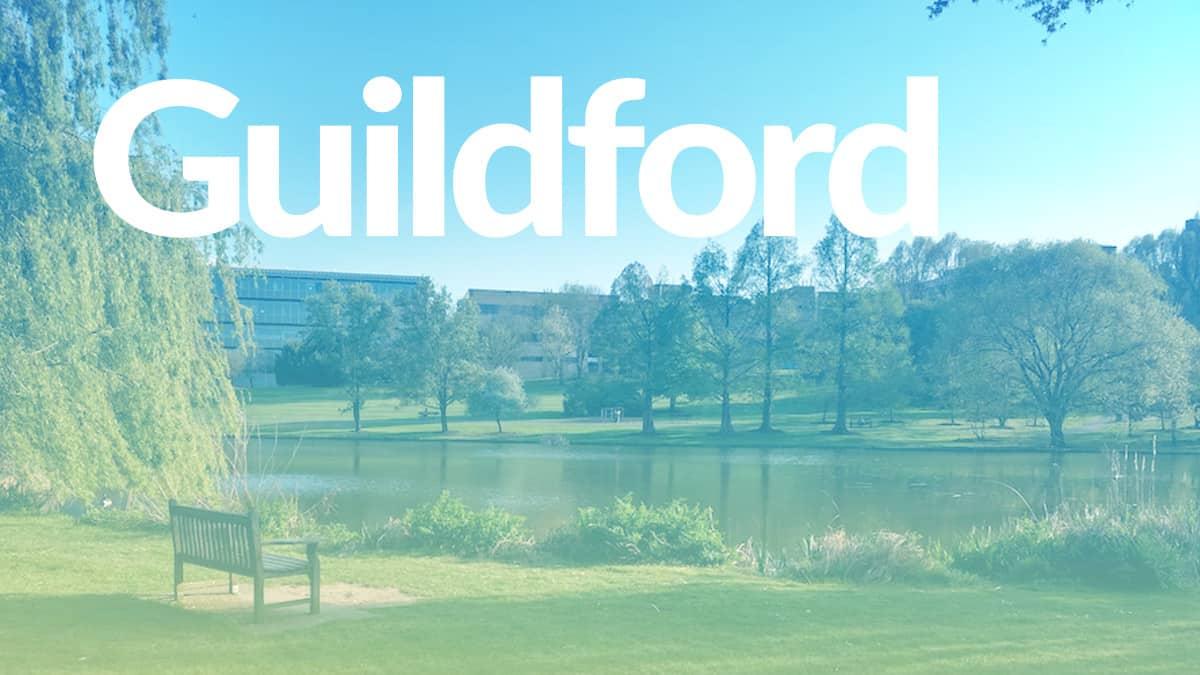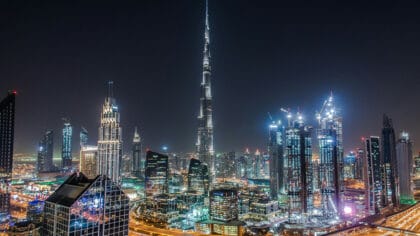Guildford is the county town of Surrey, 27 miles south west of London. Although it has both a Cathedral and University, the granting of city status is something which the Monarch awards.
The beautiful Surrey Hills sit to the east and are a regular leisure destination for those looking to enjoy the great outdoors.
The town’s principal theatre is the Yvonne Arnaud Theatre, which often shows productions after they have spent time in London’s West End.
Early Guildford
The town owes its location to the gap in the North Downs where the River Wey is forded by the Harrow Way.
In Saxon times, Guildford was known as ‘Guilden Ford’ – it might have been so-named because of golden flowers that grew by the riverside or the golden sands on the banks of the river.
It became a town in the early 10th century and has since been the residence of kings and many famous men and women, especially after Henry II turned the Norman castle into a luxurious palace. It was also the site of an early Royal Mint for around 100 years from the year 978.
In the Middle Ages, Guildford was home to a leper colony. It was located just outside the town walls, where sufferers of the disease could live and receive medical care. Today, the site’s known as “Lepers’ Acre”.
For many years in this period, Guildford’s main industry was wool. A lot of wool was fulled, which means it was cleaned and thickened by pounding in a mixture of water and clay. The wool industry declined in the 16th century due to increasing competition from the North of England.
Embed from Getty ImagesPlaces to visit:
Guildford Lido
Embed from Getty ImagesIf you fancy a swim, you should definitely check out Guildford Lido.
It’s been in continuous use since 1933, making it one of the longest-serving lidos in use today – as well as one of a handful left from the 1930s.
You’ll find it within four acres of landscaped gardens, making it ideal for poolside picnics and get-togethers.
Guildford Castle
Embed from Getty ImagesIf you like a place with stories to tell then Guildford Castle is perfect.
Built shortly after the Norman invasion in 1066, it’s been used as a Royal Palace, prison and private residence, before opening as a public garden in 1888 to mark Queen Victoria’s Golden Jubilee.
As well as its vibrant floral displays, the garden contains a life-size statue of Alice Through the Looking Glass and also the town’s war memorial.
Inside the castle there’s a model of how it might have looked in 1300 in all its glory and on the first floor the building has been preserved so you can see it as it would have been in times gone by.
If you’re feeling brave, take the winding stairs to the castle roof for a panorama of the town and the breathtaking Surrey Hills beckoning from afar!
The Angel Hotel
Embed from Getty ImagesFor hundreds of years, much of the traffic from London to Hampshire and Dorset passed through Guildford.
And given it was a two day journey from London to Portsmouth, Guildford was a convenient place to stay the night, and the town earned a good reputation for its inns.
The Angel Hotel is the Guildford’s sole survivor of its five coaching inns.
Established in the Middle Ages, it has Tudor timber-framing behind a Regency façade, and a 14th century stone undercroft.
Some of its famous guests over the years have included Lord Nelson, Charles Dickens, Lord Byron and Jane Austen.
The High Street
Embed from Getty ImagesGuildford’s high street is a gem – with its cobbled street, historic buildings and famous Guildhall clock, it’s one of the most attractive high streets in the country, although does climb a hill!
Two buildings to spot are Guildford House – a 17th century town house that hosts a variety of activities, including galleries and exhibitions. Its art collection includes works of Guildford and the surrounding area, and works by Guildford artists, most notably John Russell R.A.
And the 16th century Guildhall, originally a market hall, was substantially remodeled in 1683 with a new facade and a council chamber on the first floor. The front is dominated by a magnificent clock.
Guildford Cathedral
Embed from Getty ImagesStanding proud on Stag Hill is Guildford Cathedral.
Consecrated in 1961, it was the first cathedral to be built in the South of England since medieval times, and was uniquely funded by more than 200,000 people buying a brick.
It was consecrated by Queen Elizabeth and made its screen debut in the 1976 cult classic horror movie, The Omen.
The River Wey
Embed from Getty ImagesRivers have played important roles in the development of many towns and the River Wey played that role here, connecting Guildford to a network of waterways that aided the town’s prosperity.
In fact, the River Wey was one of the first British rivers to be made navigable, with the 15-mile River Wey Navigation links Guildford to the Thames at Weybridge opening in 1653.
A visitor centre at Dapdune Wharf tells the story of the navigations and the people who lived and worked on this 360 year old waterway.
You can see some of the huge Wey barges and climb aboard ‘Reliance’, one of three surviving barges.
You could even do a boat trip!
The Spike

For a taste of hard labour, just outside of the town centre is The Spike.
This former workhouse offers an unsettling glimpse into the lives of the down and outs in the Victorian era – it tells a grim story about how the poor were treated in this country.
During the Poor Law Union years, those fit enough could keep themselves out of the workhouse proper as they could earn a little here and there through often back breaking hard work, or through trickery or a little begging.
What you like
We caught up with some children to find out their favourite places to visit in and around Guildford…
- “We went on a school trip to The Spike Heritage Centre which used to be a Victorian workhouse – it was kind of spooky but really interesting”
- “We had a really cool boat trip on the River Wey and then lunch at Dapdune Wharf”
- “Stoke Park is a good place for a picnic – we went with Nanny and Grandad and our cousins”
Famous People in Guildford
Alan Turing

Alan Turing was a code-breaker and mathematician, and a real hero.
Born in London, Guildford gave Alan his first proper home and was where he developed an interest in astronomy, spending hours star gazing and drawing the night sky.
He went on to crack enemy codes during the second world war which gave Britain vital info to help win the war.
P.G Wodehouse

Famous for writing funny books, P.G. Wodehouse was born in Guildford in 1881, although prematurely while mother was visiting the town.
He was baptised in Guildford – at St Nicolas’ Church, with the names Pelham Grenville. and became well known for his witty and humorous writing, creating beloved characters like Bertie Wooster and his butler Jeeves.
He often write about upper-class British society, showcasing absurd situations and hilarious misunderstandings.
You’ll also find a lot of golf in his stories – he loved to play and it makes a great setting for comedy!
His writings are also often full of witty and memorable quotes – in particular, “He had the look of one who had drunk the cup of life and found a dead beetle at the bottom.”
Lewis Carroll
Embed from Getty ImagesLewis Carroll is most famous for writing Alice’s Adventures in Wonderland!
His real name was actually Charles Lutwidge Dodgson.
At an early age, he showed great aptitude for mathematics and a whimsical imagination.
It was during his time at Oxford that he developed a close friendship with the Liddell family, including Alice Liddell who was the inspiration for his famous character.
He never had a home in Guildford but first came here in 1868 on a house hunting expedition for his sisters who moved into The Chestnuts, a roomy house near the Castle.
He loved a walk, and when in Guildford was very fond of a tramp over the downs or a walk along the Hog’s Back to Farnham.
It was on one of these walks that the last line of his nonsense masterpiece ‘The Hunting of the Snark’ came into his head.
Lewis Carroll spent his last Christmas in Guildford in 1897, sadly catching influenza and dying at The Chestnuts in January 1898. He’s buried in the cemetery on The Mount.
George Frederic Watts and Mary Watts

And one last famous couple with attachments to the town are George Frederic Watts and the designer and artist Mary Watts.
In nearby Compton is a very impressive art establishment – Watts Gallery.
Founded in 1904, the gallery is devoted to their life and work.
George was a brilliant 19th century artist – he painted portraits, landscapes and pictures exploring themes and ideas of the time, such as the Irish Famine and animal cruelty. He was greatly inspired by time in Italy and the art he saw there. This, and his reputation as a talented painter and sculptor, earned him the title of ‘England’s Michelangelo’.
His wife Mary was an artist, designer, writer, businesswoman and philanthropist whose art and creativity supported and inspired people around her.
A SOUTH WESTERN RAILWAY TRAIN TICKET OPENS A WORLD OF POSSIBILITIES… WHERE WILL YOURS TAKE YOU?
TRACKSIDE IS AN INSPIRING AUDIO PRODUCTION FUNDED BY A SOUTH WESTERN RAILWAY CUSTOMER AND COMMUNITIES IMPROVEMENT FUND GRANT.








